Copper:
- Copper price breaches USD 6600 per ton, the highest level in the last two years
- The correlation between copper and credit impulse in China (18 months lead) indicates that the price of copper may be heading for a local high, but in the long run copper prices may also continue to increase
- The rebound of copper prices after the previous financial crisis suggests that the price of copper may rise at least to around USD 7,000 per ton
- However, copper has risen slightly higher than the short-term fundamentals would suggest. Global inventories are consolidating, while inventories in Shanghai are rebounding for the second week in a row
- If copper is used excessively to secure loans in China, as it was in 2014, this may be a warning signal for the price
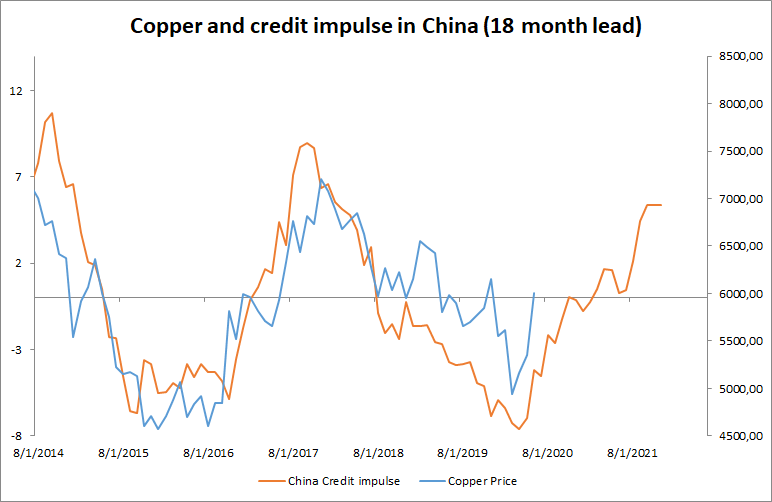 Credit impulse in China suggests that copper prices will rise in the coming months. The latest infrastructure support program worth billions yuan should generate an increase in demand for copper. Source: Bloomberg, XTB
Credit impulse in China suggests that copper prices will rise in the coming months. The latest infrastructure support program worth billions yuan should generate an increase in demand for copper. Source: Bloomberg, XTB
Kezdjen befektetni még ma, vagy próbálja ki ingyenes demónkat
SZÁMLANYITÁS Mobil app letöltése Mobil app letöltése Copper inventories in Shanghai are starting to recover. Inventories on the most important global stock exchanges are consolidating. However, copper has moved too far in comparison to short-term fundamental factors (inverted price axis). Source: Bloomberg
Copper inventories in Shanghai are starting to recover. Inventories on the most important global stock exchanges are consolidating. However, copper has moved too far in comparison to short-term fundamental factors (inverted price axis). Source: Bloomberg
Gold:
- Bloomberg indicates that gold is overvalued as a raw material, but is relatively cheap when looking at gold as a currency
- According to the Bloomberg statistical model, price of gold should fall below USD 1,700 per ounce
- Gold is slightly overvalued relative to the emerging markets (MSCI EM)
- However, central bank balance sheets indicate that gold is generally cheap in the long run and has growth prospects
- ETFs continue to buy gold. Long and short positioning are rebouncing, which means that speculators return to the market
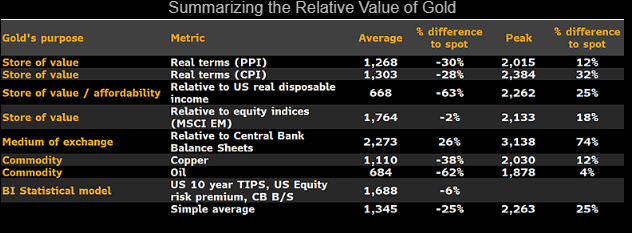 Gold is overvalued when looking at inflation, valuations relative to other assets, or statistical models. On the other hand, gold is cheap when viewed as currency. Moreover, most factors show that gold is still far from its historical highs. Source: Bloomberg
Gold is overvalued when looking at inflation, valuations relative to other assets, or statistical models. On the other hand, gold is cheap when viewed as currency. Moreover, most factors show that gold is still far from its historical highs. Source: Bloomberg
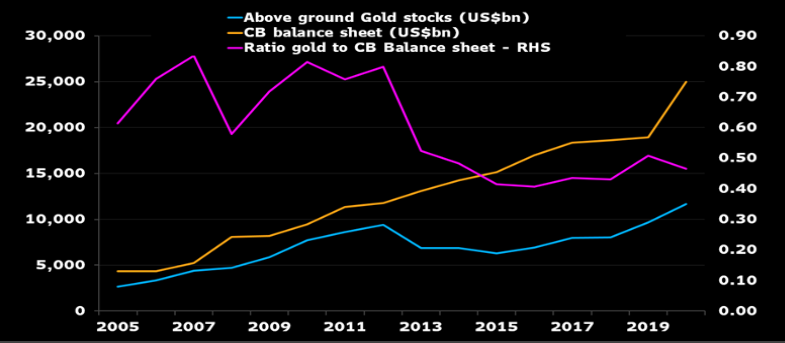 The share of gold in central banks' balance sheets is low compared to the last financial crisis. This shows that gold in the long run is really cheap considering the huge amount of cash which is available on the market. Source: Bloomberg
The share of gold in central banks' balance sheets is low compared to the last financial crisis. This shows that gold in the long run is really cheap considering the huge amount of cash which is available on the market. Source: Bloomberg

ETFs buy gold, speculators are increasingly active on the market. Source: Bloomberg
Oil:
- Oil remains below an important resistance level: USD 41 for WTI and USD 45 for Brent
- Iraq and Nigeria achieved much lower compliance of the agreed output cut,
- On Wednesday, July 15, OPEC + will meet online to consider extending strong production cuts (nearly 10 million barrels per day). The market expects, however, that OPEC will abandon this idea and from August production will be reduced to 8 million barrels per day
- The market is afraid that demand will no longer strongly rebound in the following months, which may lead to market stagnation
- Bloomberg indicates that after a rebound in Q3, both demand and supply will stabilize.
- The model based on marginal costs of production with a forecast of demand at the end of the year indicates that the price of oil should rise to around USD 45-50 per barrel
- Oil imports by China in June amounted to 11.4 million barrels per day and were 17% higher compared to March due to increased industrial activity and filling of the strategic reserves. China is expected to reduce its oil imports in the coming months. At the same time, oil demand in Japan or Korea fell to the lowest level in several months (according to Bloomberg data)
- China is currently responsible for an approximate 46% increase in oil demand
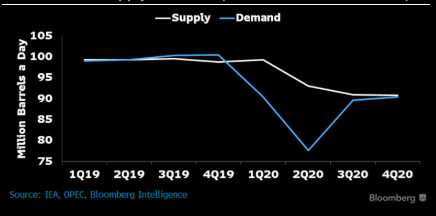 Supply and demand are expected to stabilize in the second half of the year. Based on marginal costs of extraction, the price of oil should rise to around USD 45-50 per barrel. In the short term, however, a fall in prices is possible if inventory levels will continues to increase globally and in the US. Source: Bloomberg
Supply and demand are expected to stabilize in the second half of the year. Based on marginal costs of extraction, the price of oil should rise to around USD 45-50 per barrel. In the short term, however, a fall in prices is possible if inventory levels will continues to increase globally and in the US. Source: Bloomberg
 Asia is responsible for more than 3/4 of the increase in global oil demand. Source: Bloomberg
Asia is responsible for more than 3/4 of the increase in global oil demand. Source: Bloomberg
Soy:
- Soybean prices are continuing to decline, which may be associated with increased tensions between the US and China
- A recent WASDE monthly report showed that soybean inventories increased significantly, above market expectations
- Soybean prices should continue to fall according to seasonality
- Soy remains heavily overbought looking at the COT report (bottom of the chart on xStation5)
- Interestingly, the price of soy fell on Monday, even despite a report indicating a decline in US crop quality (from 71% to 68%)
 A recent WASDE report showed inventory growth compare to the previous estimates. Source: Bloomberg
A recent WASDE report showed inventory growth compare to the previous estimates. Source: Bloomberg
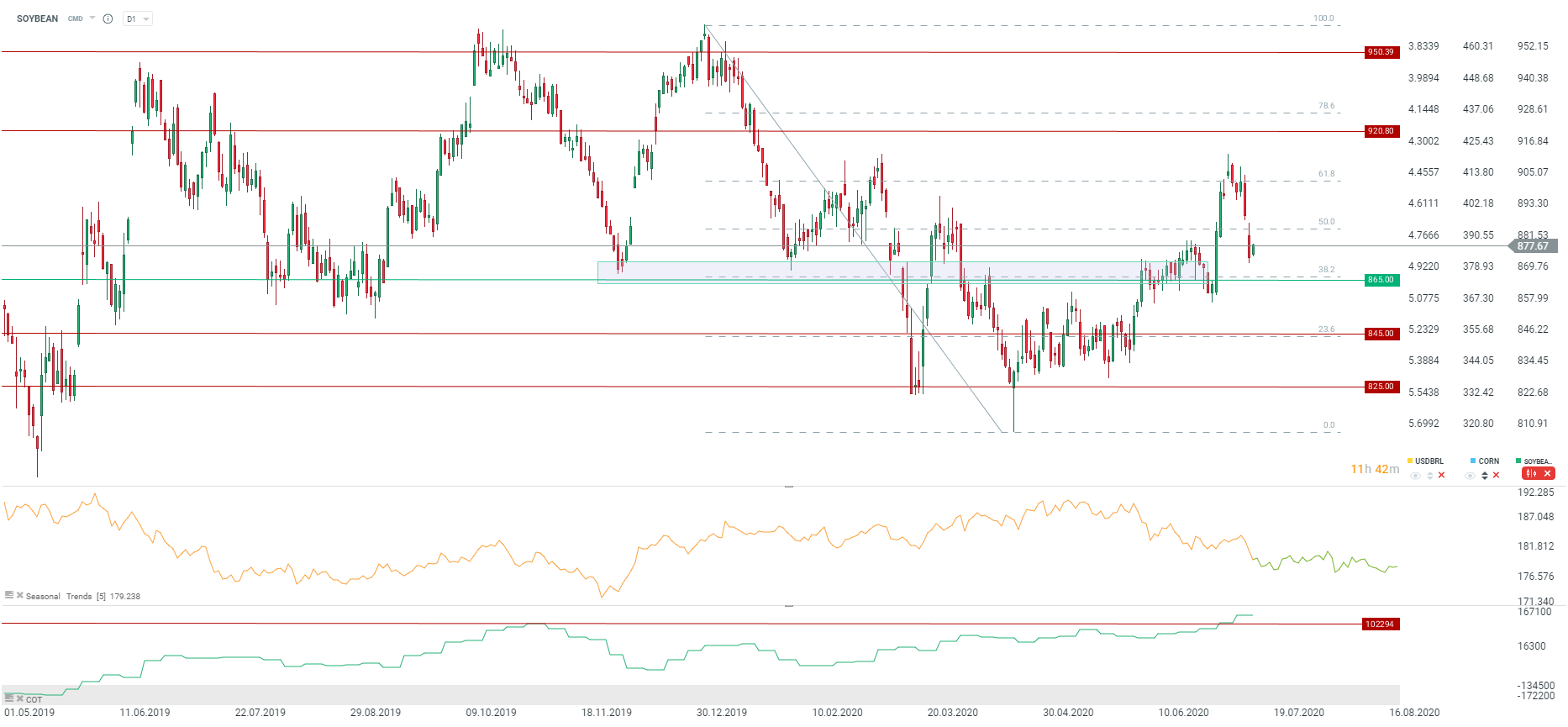 The price of soy has dropped considerably recently. The seasonality indicator shows further declines. Positioning indicates that soy is overbought. Source: xStation5
The price of soy has dropped considerably recently. The seasonality indicator shows further declines. Positioning indicates that soy is overbought. Source: xStation5
Ezen tartalmat az XTB S.A. készítette, amelynek székhelye Varsóban található a következő címen, Prosta 67, 00-838 Varsó, Lengyelország (KRS szám: 0000217580), és a lengyel pénzügyi hatóság (KNF) felügyeli (sz. DDM-M-4021-57-1/2005). Ezen tartalom a 2014/65/EU irányelvének, ami az Európai Parlament és a Tanács 2014. május 15-i határozata a pénzügyi eszközök piacairól , 24. cikkének (3) bekezdése , valamint a 2002/92 / EK irányelv és a 2011/61 / EU irányelv (MiFID II) szerint marketingkommunikációnak minősül, továbbá nem minősül befektetési tanácsadásnak vagy befektetési kutatásnak. A marketingkommunikáció nem befektetési ajánlás vagy információ, amely befektetési stratégiát javasol a következő rendeleteknek megfelelően, Az Európai Parlament és a Tanács 596/2014 / EU rendelete (2014. április 16.) a piaci visszaélésekről (a piaci visszaélésekről szóló rendelet), valamint a 2003/6 / EK európai parlamenti és tanácsi irányelv és a 2003/124 / EK bizottsági irányelvek hatályon kívül helyezéséről / EK, 2003/125 / EK és 2004/72 / EK, valamint az (EU) 2016/958 bizottsági felhatalmazáson alapuló rendelet (2016. március 9.) az 596/2014 / EU európai parlamenti és tanácsi rendeletnek a szabályozási technikai szabályozás tekintetében történő kiegészítéséről a befektetési ajánlások vagy a befektetési stratégiát javasló vagy javasló egyéb információk objektív bemutatására, valamint az egyes érdekek vagy összeférhetetlenség utáni jelek nyilvánosságra hozatalának technikai szabályaira vonatkozó szabványok vagy egyéb tanácsadás, ideértve a befektetési tanácsadást is, az A pénzügyi eszközök kereskedelméről szóló, 2005. július 29-i törvény (azaz a 2019. évi Lap, módosított 875 tétel). Ezen marketingkommunikáció a legnagyobb gondossággal, tárgyilagossággal készült, bemutatja azokat a tényeket, amelyek a szerző számára a készítés időpontjában ismertek voltak , valamint mindenféle értékelési elemtől mentes. A marketingkommunikáció az Ügyfél igényeinek, az egyéni pénzügyi helyzetének figyelembevétele nélkül készül, és semmilyen módon nem terjeszt elő befektetési stratégiát. A marketingkommunikáció nem minősül semmilyen pénzügyi eszköz eladási, felajánlási, feliratkozási, vásárlási felhívásának, hirdetésének vagy promóciójának. Az XTB S.A. nem vállal felelősséget az Ügyfél ezen marketingkommunikációban foglalt információk alapján tett cselekedeteiért vagy mulasztásaiért, különösen a pénzügyi eszközök megszerzéséért vagy elidegenítéséért. Abban az esetben, ha a marketingkommunikáció bármilyen információt tartalmaz az abban megjelölt pénzügyi eszközökkel kapcsolatos eredményekről, azok nem jelentenek garanciát vagy előrejelzést a jövőbeli eredményekkel kapcsolatban.

